The Nutanix Cloud Bible
The purpose of The Nutanix Cloud Bible is to provide in-depth technical information about the Nutanix platform architecture and how it can enable smooth operations across cloud, edge, and core environments.
» Download this section as PDF (opens in a new tab/window)
Note: The Nutanix v4 APIs are the recommended version for all use cases. This introduction will focus on the v4 Prism Central APIs; legacy APIs (v1, v2 and v3) should only be used when the a specific function or feature is not available in the v4 APIs.
The Prism Central REST API exposes nearly every capability and data point of the Prism Central UI and allows for orchestration or automation tools to easily drive Nutanix actions. This enables tools like Terraform, Ansible, Saltstack, Puppet, Ansible and more to easily create custom workflows for Nutanix. Also, this means that any third-party developer could create their own custom UI and pull in Nutanix data via REST.
The following figure shows a small snippet of the Nutanix REST API explorer which allows developers to interact with the API and see expected data formats.
All Nutanix v4 API documentation is accessed through the new documentation portal, available at https://developers.nutanix.com. The screenshot below shows the home page for the Nutanix v4 API documentation.
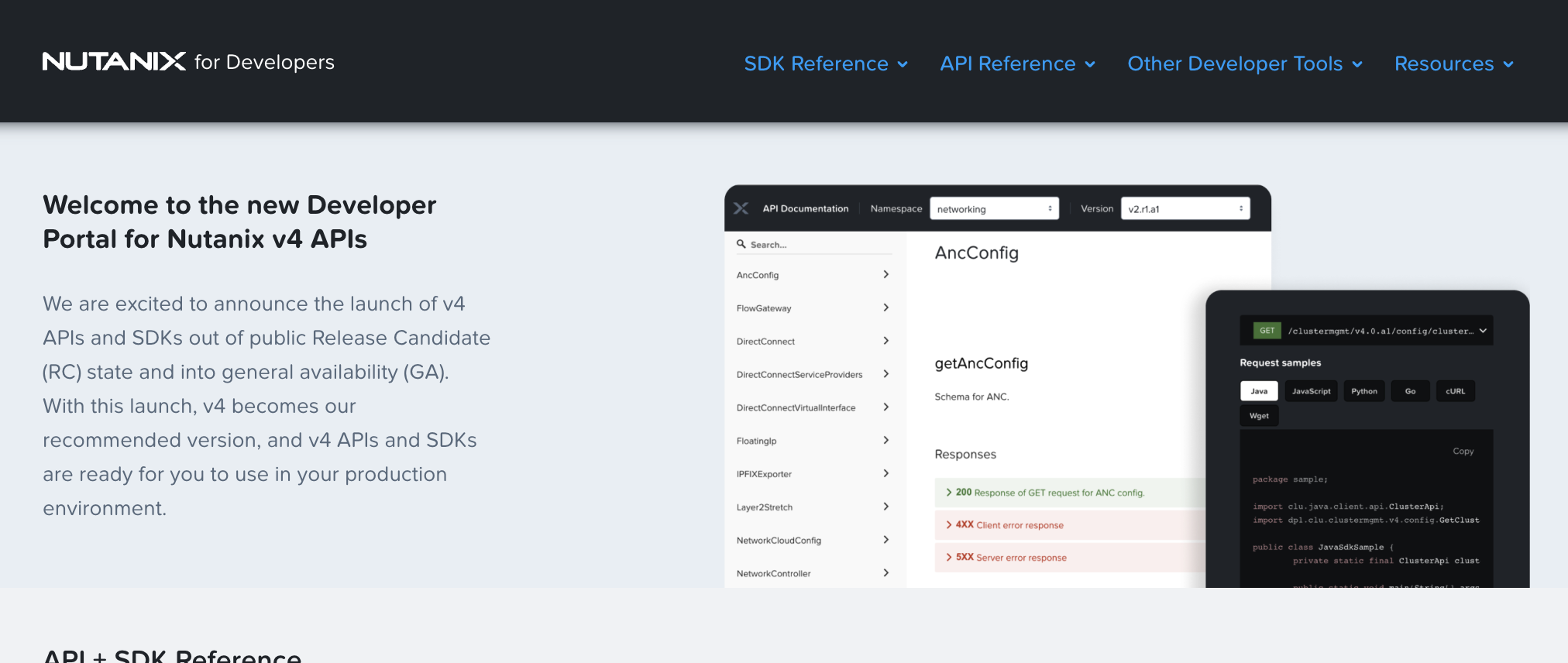
Note: Legacy v3 APIs are still supported in the Nutanix REST API Explorer, available when logged into Prism Central.
The following language-specific SDKs are currently available.
Legacy APIs are still supported in the Nutanix REST API Explorer, as shown in the screenshots below.
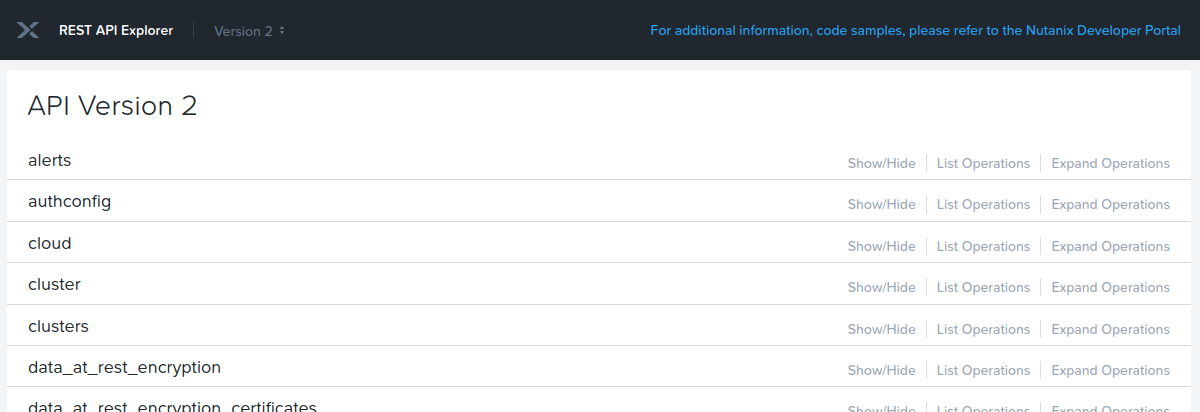
Operations can be expanded to display details and examples of the REST call:
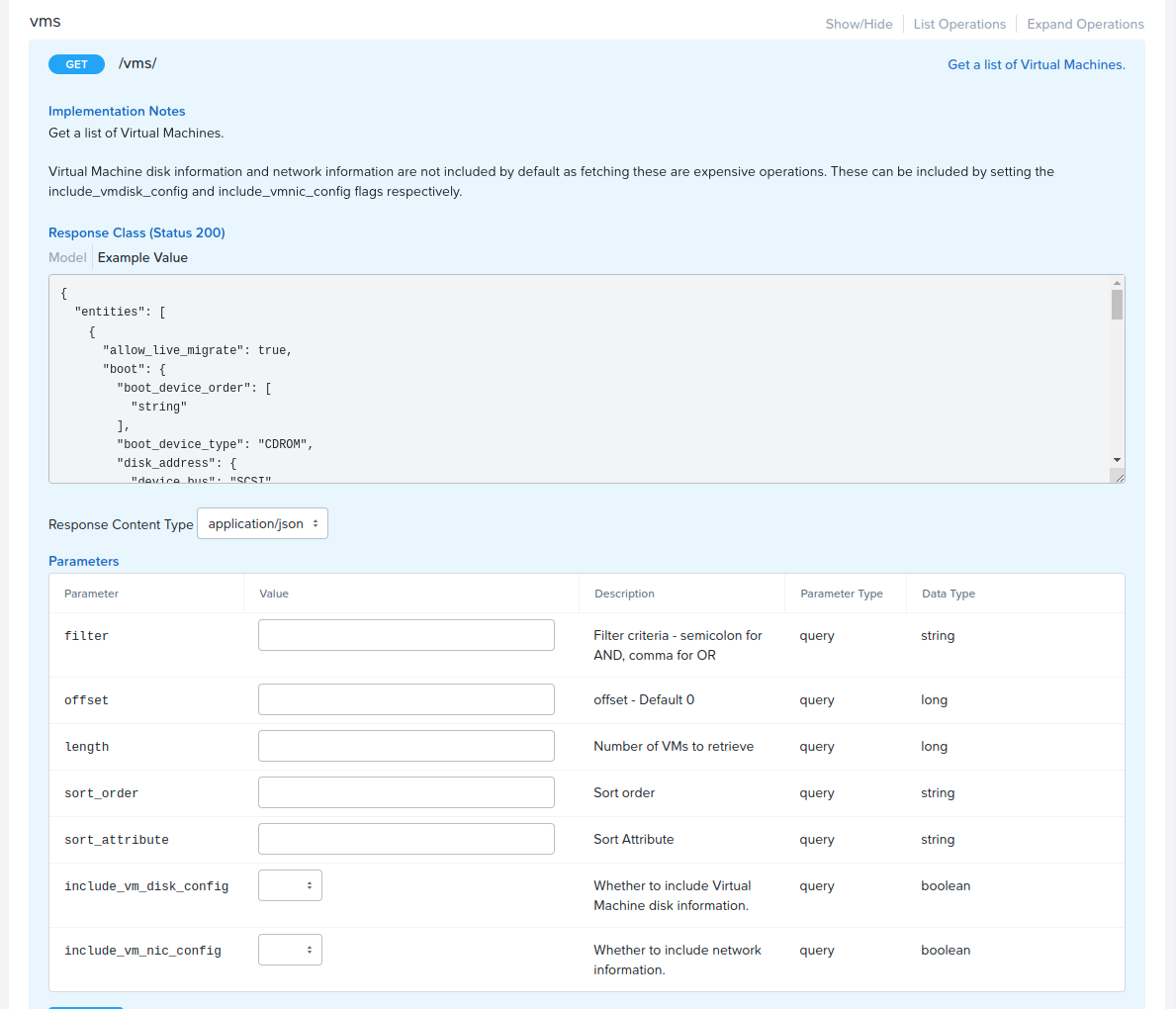
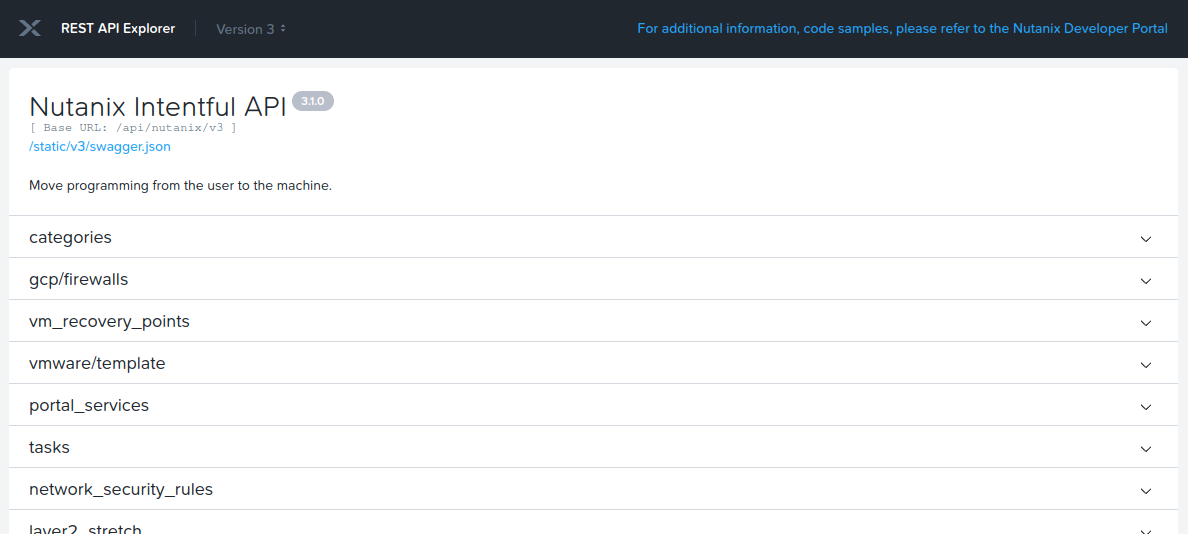
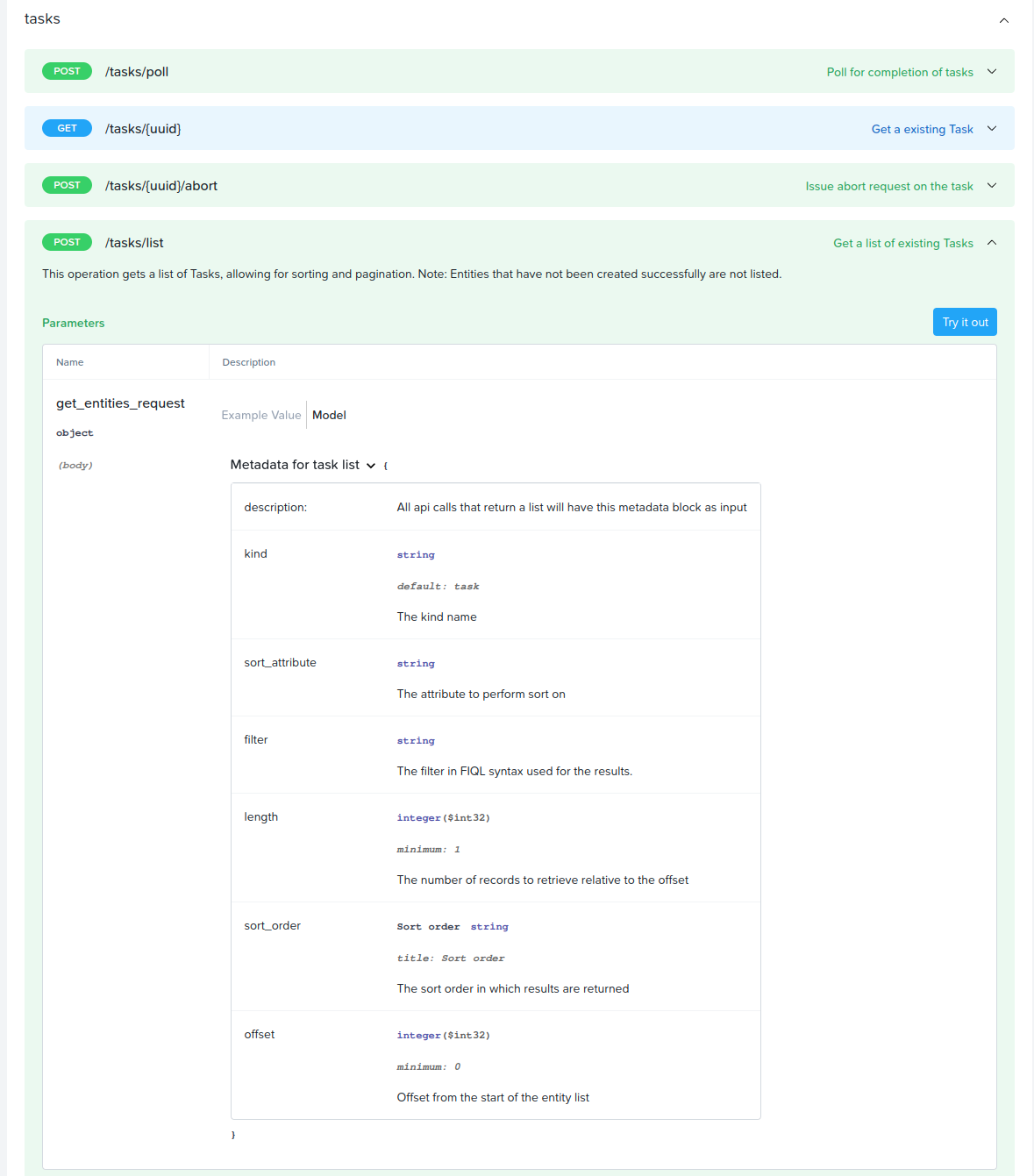
Nutanix v4 REST APIs support two authentication types:
Authentication may be completed in two “modes”:
Nutanix IAM Authorization Policies can apply granular control over specific actions a user can complete.
Nutanix Prism Element and Prism Central currently offer three generally available APIs:
For detailed information on the available API versions and the operations they expose, see API Versions on Nutanix.dev.
A non-exhaustive list of Nutanix products that can be fully or partially managed by API is as follows. Documentation is linked, where appropriate.
For a complete list of all API references, see Nutanix.dev API Reference.
Current GA and primary REST API for all Prism Central programmatic operations.
Note: Provided for legacy and backwards-compatibility support only.
The chosen API will depend on the required operations.
Prism Central v3 is multi-cluster and available through Prism Central only. It exposes operations that can impact multiple clusters such as distributed disk images, NCM Self-Service (formerly Calm) blueprints and apps, marketplace items and network security rules.
Prism Element v2.0 is cluster-local and available through Prism Element only. It exposes operations specific to the local cluster entities such as storage containers, data-at-rest encryption, storage pools and hosts.
Accessible through Nutanix Prism Central only; all API requests are as constructed as follows.
METHOD https://PRISM_CENTRAL_IP_OR_FQDN:9440/api/NAMESPACE/VERSION/PATH/ACTIONS
Example of a request to list all Prism Central images, assuming the Prism Central IP is 192.168.1.110.
GET https://192.168.1.110:9440/api/vmm/v4.0/content/images
Example of image creation:
POST https://192.168.1.110:9440/api/vmm/v4.0/content/images
Accompanied by image configuration in JSON format. For example:
{
"name": "",
"type": "DISK_IMAGE",
"description": "Image created with Nutanix v4 APIs",
"source": {
"url": "",
"$objectType": "vmm.v4.content.UrlSource"
},
"clusterLocationExtIds": [
""
]
}To ensure request idempotency, this request must be accompanied by the Ntnx-Request-Id header, the value of which is a UUID that uniquely identifies this specific request. UUID generation will vary by environment but can be generated by various online tools.
The response from this request contains the task status, indicated by the data.extId field. This task, when viewed in Prism Central or via API, would show the operation’s status, including percentage complete and any errors that occurred during the process.
{
"data": {
"$reserved": {
"$fv": "v4.r0"
},
"$objectType": "prism.v4.config.TaskReference",
"extId": "ZXJnb24=:447c5e9e-b7ad-408e-ae4f-82de667ef72e"
},
"$reserved": {
"$fv": "v4.r0"
},
"$objectType": "vmm.v4.content.CreateImageApiResponse",
"metadata": {
"flags": [
{
"$reserved": {
"$fv": "v1.r0"
},
"$objectType": "common.v1.config.Flag",
"name": "hasError",
"value": false
},
{
"$reserved": {
"$fv": "v1.r0"
},
"$objectType": "common.v1.config.Flag",
"name": "isPaginated",
"value": false
},
{
"$reserved": {
"$fv": "v1.r0"
},
"$objectType": "common.v1.config.Flag",
"name": "isTruncated",
"value": false
}
],
"$reserved": {
"$fv": "v1.r0"
},
"$objectType": "common.v1.response.ApiResponseMetadata",
"links": [
{
"$reserved": {
"$fv": "v1.r0"
},
"$objectType": "common.v1.response.ApiLink",
"href": "https://192.168.1.110:9440/api/prism/v4.0/config/tasks/ZXJnb24=:447c5e9e-b7ad-408e-ae4f-82de667ef72e",
"rel": "self"
},
{
"href": "https://192.168.1.110:9440/api/vmm/v4.0/content/images",
"rel": "image-list"
}
]
}
}To use this example in your own environment, change the `` variables to those matching your requirements.
Nutanix Prism API v3 is available through Prism Central only. All API requests are as constructed as follows.
METHOD https://PRISM_CENTRAL_IP:9440/api/nutanix/v3/API_NAME/VARIABLES
Example of a request to list all virtual machines, assuming the Prism Central IP is 192.168.1.110.
POST https://192.168.1.110:9440/api/nutanix/v3/vms/list
Accompanied by an appropriate payload in JSON format. In this example Prism Central is instructed to return all items of type vm.
{
"kind": "vm"
}
Example of VM creation:
POST https://192.168.1.110:9440/api/nutanix/v3/vms
Accompanied by VM configuration in JSON format. For example:
{
"spec": {
"name": "vm_api_v3",
"resources": {},
"cluster_reference": {
"uuid": "0005f2f7-eee7-1995-6145-ac1f6b35fe5e",
"kind": "cluster"
}
},
"metadata": {
"kind": "vm"
}
}The response from this request contains the task status, currently PENDING, and task details including the cluster that owns the new VM and a task_uuid that can be queried using the tasks API.
{
"status": {
"state": "PENDING",
"execution_context": {
"task_uuid": "1c64cc8b-241d-4132-955f-f6e26239ac02"
}
},
"spec": {
"name": "vm_api_v3",
"resources": {},
"cluster_reference": {
"kind": "cluster",
"uuid": "0005f2f7-eee7-1995-6145-ac1f6b35fe5e"
}
},
"api_version": "3.1",
"metadata": {
"use_categories_mapping": false,
"kind": "vm",
"spec_version": 0,
"uuid": "d965afdc-4606-4a0b-bc99-f868ae615039"
}
}To use this example in your own environment, change the cluster uuid to a value appropriate for your cluster.
For more information see, Create a new VM in the Nutanix.dev API reference.
Nutanix Prism API v2.0 is available through Prism Element only. All API requests are as constructed as follows.
METHOD https://CVM_OR_CLUSTER_IP:9440/api/nutanix/v2.0/API_NAME/VARIABLES
Example of a request to list all storage containers, assuming the cluster IP is 192.168.1.100.
GET https://192.168.1.100:9440/api/nutanix/v2.0/storage-containers
Example of VM creation:
POST https://192.168.1.100:9440/api/nutanix/v2.0/vms
Accompanied by VM configuration in JSON format. For example:
{
"description": "VM created by v2.0 API",
"memory_mb": 1024,
"name": "vm_api_v2.0",
"num_vcpus": 1,
"num_cores_per_vcpu": 1,
"vm_disks": [
{
"is_cdrom": false,
"vm_disk_create": {
"size": 128849018880,
"storage_container_uuid": "b2fefc62-6274-4c84-8e6c-a61f5313ea0e"
}
}
]
}The response from this request contains a Prism task UUID that can be queried using the prism namespace’s tasks API.
{
"task_uuid": "eec7d743-b6c7-4c6d-b821-89b91b142f1d"
}To use this example in your own environment, change storage_container_uuid to a value appropraite for your cluster.
For more information see Create a Virtual Machine in the Nutanix.dev API reference.
Note: The /api/nutanix/v2.0 path is an alias for /PrismGateway/services/rest/v2.0. The PrismGateway path will often be referenced in the Prism API v2.0 documentation; both paths can be used interchangeably and will produce identical results.
©2025 Nutanix, Inc. All rights reserved. Nutanix, the Nutanix logo and all Nutanix product and service names mentioned are registered trademarks or trademarks of Nutanix, Inc. in the United States and other countries. All other brand names mentioned are for identification purposes only and may be the trademarks of their respective holder(s).